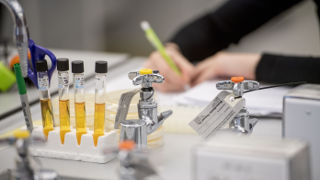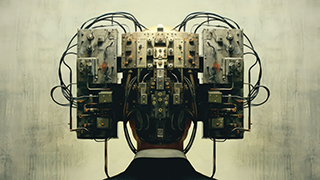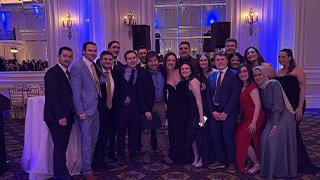Biophysics Laboratory Inspires Scholars
Monday, July 20, 2020

"Students join the research team in the biophysics lab, learn about the research subject,
and gain essential experimental and analytical skills to directly collaborate on research
projects," said Mitra Shojania Feizabadi, Ph.D., professor of physics and the lab's director.
On a daily basis, students bring innovative ideas and creative approaches that facilitate them in achieving their research goals. Their enthusiasm constantly adds to the spirit and momentum of research on the team, as the lab has a truly collaborative atmosphere.
Over the last five years, six undergraduate students of the biophysics research team have gained co-authorships in four peer-reviewed papers published in Biochemical and Biophysical Research Communications, Biophysical and Biochemical Reports, and International Journal of Molecular Sciences. Two papers that recently published are:
1) "A Confirmation for the Positive Electric Charge of Bio-Molecular Motors through
Utilizing a Novel Nano-Technology Approach in Vitro." Feizabadi, M.S.; *Alejilat, R.S.; *Duffy, A.B.; *Breslin, J.C.; *Akintola, I.I.
Int. J. Mol. Sci. 2020, 21, 4935.
2) "The Regulatory Effect of Tau Protein on Polymerization of MCF7 Microtubules in Vitro" Feizabadi, M.S.; *Hernandez, A.V. M.; *Breslin J.C.; *Akintola I.I. Biochemistry and Biophysics Reports. 2019, 17,151.
* indicates undergraduate students co-authors
Collectively, the high level of responsibilities and success that the undergraduate students show in their coursework, along with their tangible accomplishments in research, have established a foundation for them to successfully follow their goals, including entering prestigious graduate programs. Many research students in the biophysics lab in recent years have moved on to graduate work in the field. These include Kirk Mutafopulos ‘12, who joined the master's program in biomedical engineering at Cornell University. He then pursued his Ph.D. at Harvard University in applied physics. He recently completed his Ph.D. and has joined the biotechnology engineering and manufacturing company Cytonome. Another biophysics lab alum who moved on to graduate studies in the field is Carly Winton ‘13, who joined the master's program in biomedical engineering at Virginia Tech. In the fall of 2020, Diego Espinoza ‘20 will begin his studies in the master's program in biomedical engineering at University of California, Berkeley.
While research team members are normally interested in pursuing the next step of their
professional career at the intersection of biology and physics, some view their experience
as an opportunity to build a research foundation for the next step in their professional
careers in other fields. Ibukunoluwa (Ibu) Atinkola ‘20 will join the Ph.D. program
in Mechanical Engineering at Notre Dame University, and Jane Breslin'20 will join
the master's program in mechanical engineering at Clemson University in Fall 2020.
"Engaging undergraduate students in cutting-edge research, having a small role in
their achievements, and observing their advancement is a joy and a step toward maintaining
a strong undergraduate science experience for students," Professor Shojania Feizabadi
remarked.
Categories: Science and Technology





